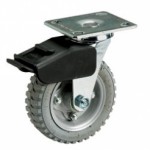With so many casters and wheels options available, it can be quite the challenge to make a selection for your application. Let’s cover the first few important steps prior to purchasing casters for your application.

First and foremost is Caster Capacity. The caster capacity is the total weight an individual caster can support. In order to figure which caster capacity best suits your application you must follow this equation… Divide the total weight of the maximum load you will be needing the casters and wheels for by the number of casters you are going to attach to the dollie. Now choose the casters and wheels with a caster capacity greater than or equal to your result.
There are guidelines for regarding types of casters and wheels and floor surface ratings that should be taken into consideration.
Asphalt: Rubber, Polyurethane and Semi to Full Pneumatics are excellent, Phenolic (molded plastic) and Polyolefin are fair, and Iron or Semi-Steel are not recommended for use on asphalt.
- Concrete: Rubber, Polyurethane and Semi to Full Pneumatics are excellent, Phenolic (molded plastic) and Polyolefin are good for use, and Iron or Semi-Steel are a fair choice.
- Tile: Rubber, Polyurethane and Semi to Full Pneumatics are excellent, Phenolic (molded plastic) and Polyolefin are fair, and Iron or Semi-Steel should not be used.
- Hardwood Flooring: Rubber, Polyurethane and Semi to Full Pneumatics are excellent, Phenolic (molded plastic) and Polyolefin are good, and Iron or Semi-Steel are not recommended what so ever.
- Carpets: Polyurethane, Semi to Full Pneumatics, Phenolic (molded plastic), and Polyolefin are all good for use, but Iron or Semi-Steel can cut in and not get very good grip while transferring.
In Part 3 of this four part blog, we’ll cover maneuverability and brakes.
